HI5017 Managerial Accounting: Report on System Implementation
VerifiedAdded on 2022/10/19
|10
|3212
|24
Report
AI Summary
This report analyzes the implementation and relevance of Management Accounting Systems (MAS) in multinational corporations. It examines how companies utilize MAS to aid managerial decision-making and achieve business goals. The report explores different management accounting methods such as Just-In-Time Inventory, Balanced Scorecard, and Total Quality Management, comparing the application of MAS in two different organizations. It also discusses the relevance of MAS in today's competitive and uncertain business environment, highlighting the use of MAS at different management levels. The report further compares the case study with another journal article, focusing on the acceptance and use of a new accounting system. Overall, the report provides a comprehensive overview of MAS, its functionalities, and its impact on organizational performance.
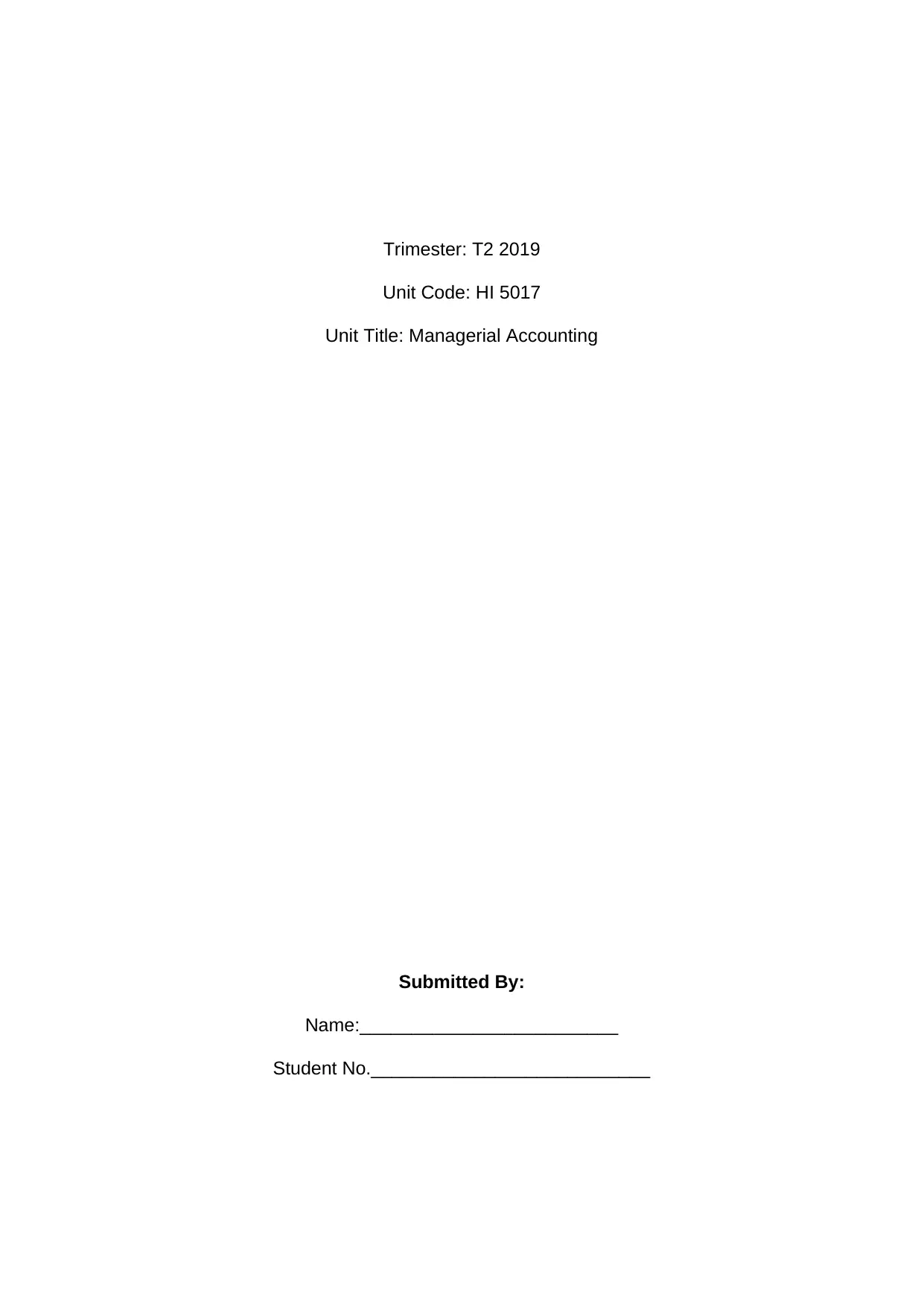
Trimester: T2 2019
Unit Code: HI 5017
Unit Title: Managerial Accounting
Submitted By:
Name:_________________________
Student No.___________________________
Unit Code: HI 5017
Unit Title: Managerial Accounting
Submitted By:
Name:_________________________
Student No.___________________________
Paraphrase This Document
Need a fresh take? Get an instant paraphrase of this document with our AI Paraphraser
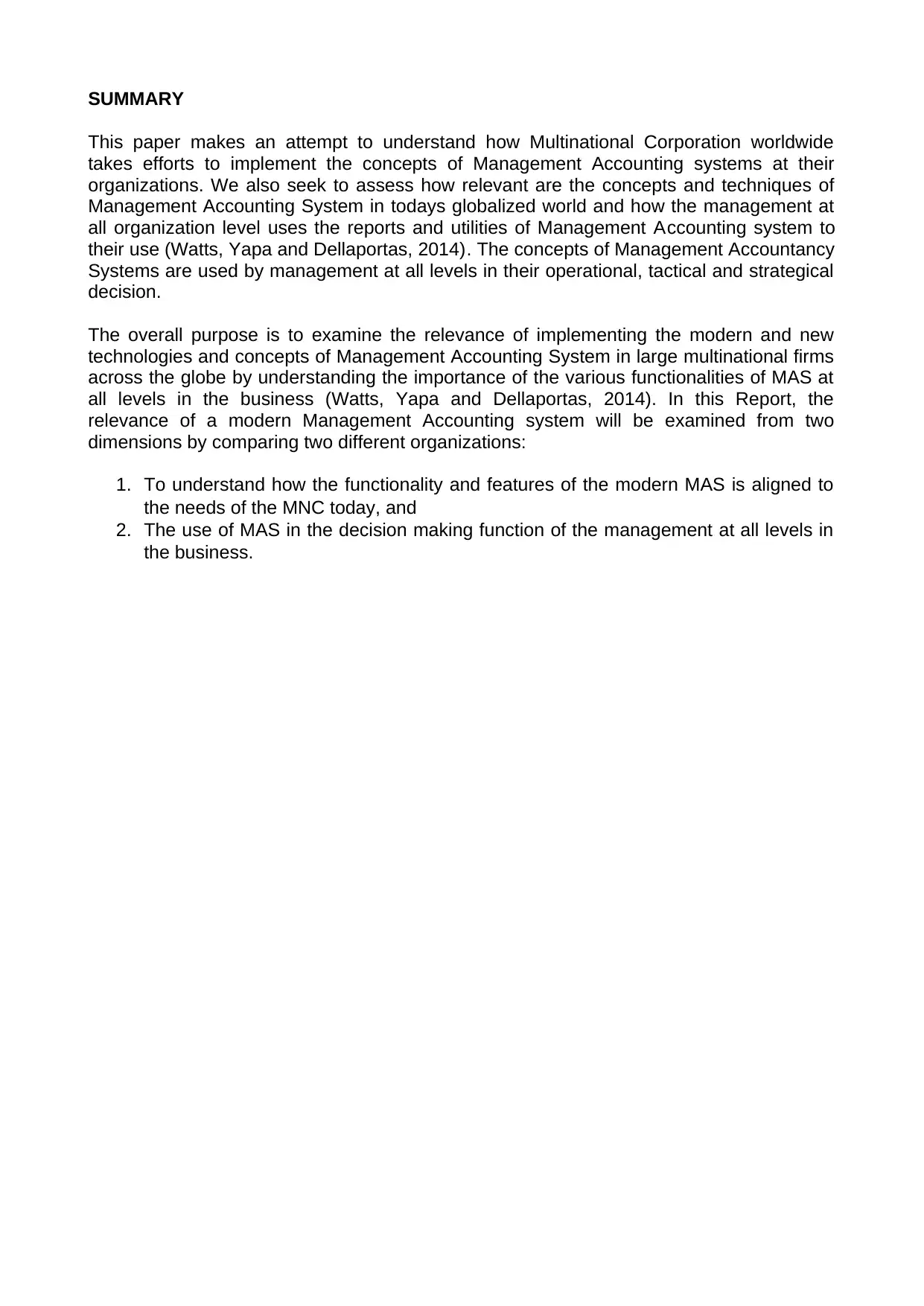
SUMMARY
This paper makes an attempt to understand how Multinational Corporation worldwide
takes efforts to implement the concepts of Management Accounting systems at their
organizations. We also seek to assess how relevant are the concepts and techniques of
Management Accounting System in todays globalized world and how the management at
all organization level uses the reports and utilities of Management Accounting system to
their use (Watts, Yapa and Dellaportas, 2014). The concepts of Management Accountancy
Systems are used by management at all levels in their operational, tactical and strategical
decision.
The overall purpose is to examine the relevance of implementing the modern and new
technologies and concepts of Management Accounting System in large multinational firms
across the globe by understanding the importance of the various functionalities of MAS at
all levels in the business (Watts, Yapa and Dellaportas, 2014). In this Report, the
relevance of a modern Management Accounting system will be examined from two
dimensions by comparing two different organizations:
1. To understand how the functionality and features of the modern MAS is aligned to
the needs of the MNC today, and
2. The use of MAS in the decision making function of the management at all levels in
the business.
This paper makes an attempt to understand how Multinational Corporation worldwide
takes efforts to implement the concepts of Management Accounting systems at their
organizations. We also seek to assess how relevant are the concepts and techniques of
Management Accounting System in todays globalized world and how the management at
all organization level uses the reports and utilities of Management Accounting system to
their use (Watts, Yapa and Dellaportas, 2014). The concepts of Management Accountancy
Systems are used by management at all levels in their operational, tactical and strategical
decision.
The overall purpose is to examine the relevance of implementing the modern and new
technologies and concepts of Management Accounting System in large multinational firms
across the globe by understanding the importance of the various functionalities of MAS at
all levels in the business (Watts, Yapa and Dellaportas, 2014). In this Report, the
relevance of a modern Management Accounting system will be examined from two
dimensions by comparing two different organizations:
1. To understand how the functionality and features of the modern MAS is aligned to
the needs of the MNC today, and
2. The use of MAS in the decision making function of the management at all levels in
the business.
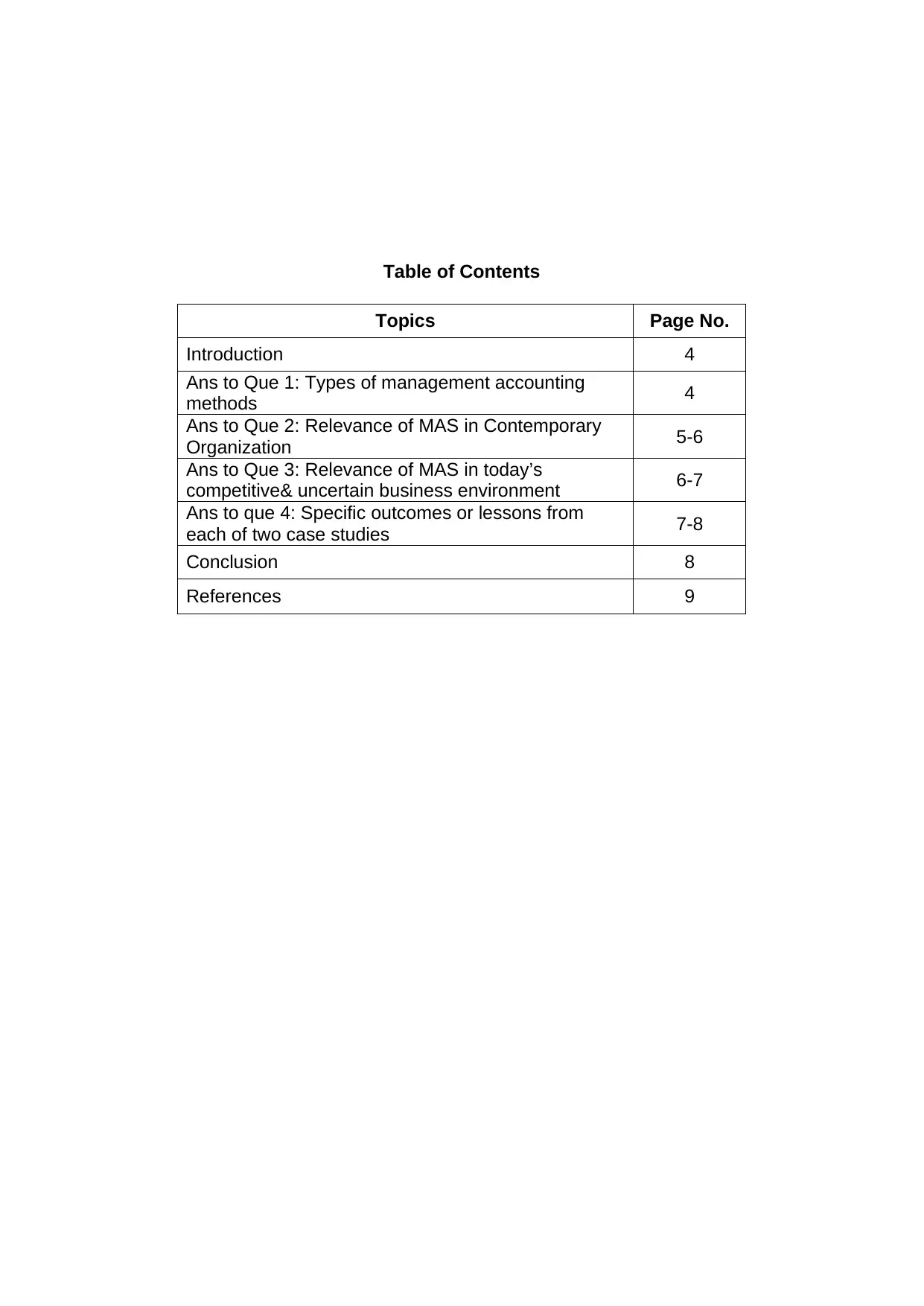
Table of Contents
Topics Page No.
Introduction 4
Ans to Que 1: Types of management accounting
methods 4
Ans to Que 2: Relevance of MAS in Contemporary
Organization 5-6
Ans to Que 3: Relevance of MAS in today’s
competitive& uncertain business environment 6-7
Ans to que 4: Specific outcomes or lessons from
each of two case studies 7-8
Conclusion 8
References 9
Topics Page No.
Introduction 4
Ans to Que 1: Types of management accounting
methods 4
Ans to Que 2: Relevance of MAS in Contemporary
Organization 5-6
Ans to Que 3: Relevance of MAS in today’s
competitive& uncertain business environment 6-7
Ans to que 4: Specific outcomes or lessons from
each of two case studies 7-8
Conclusion 8
References 9
⊘ This is a preview!⊘
Do you want full access?
Subscribe today to unlock all pages.

Trusted by 1+ million students worldwide
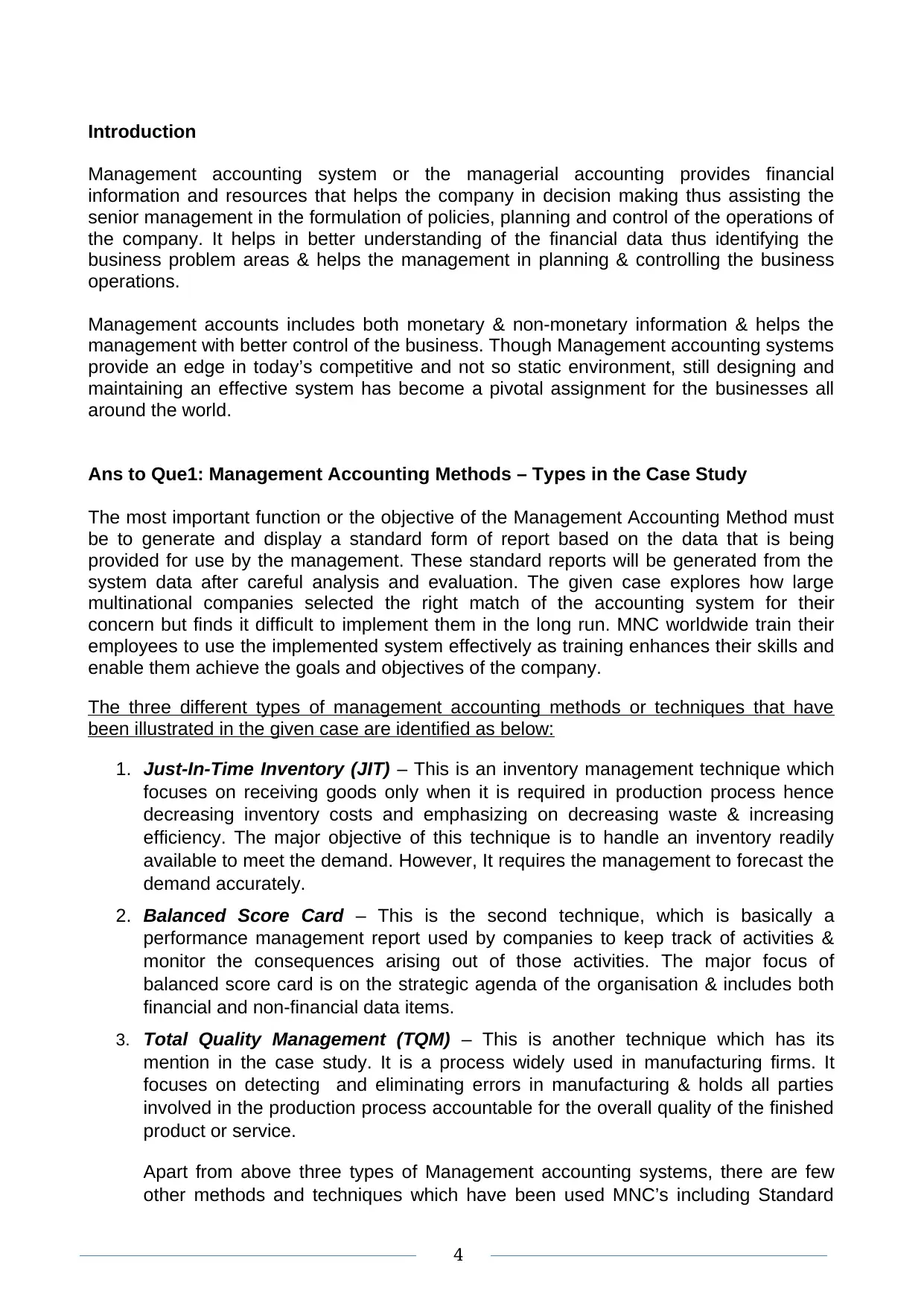
Introduction
Management accounting system or the managerial accounting provides financial
information and resources that helps the company in decision making thus assisting the
senior management in the formulation of policies, planning and control of the operations of
the company. It helps in better understanding of the financial data thus identifying the
business problem areas & helps the management in planning & controlling the business
operations.
Management accounts includes both monetary & non-monetary information & helps the
management with better control of the business. Though Management accounting systems
provide an edge in today’s competitive and not so static environment, still designing and
maintaining an effective system has become a pivotal assignment for the businesses all
around the world.
Ans to Que1: Management Accounting Methods – Types in the Case Study
The most important function or the objective of the Management Accounting Method must
be to generate and display a standard form of report based on the data that is being
provided for use by the management. These standard reports will be generated from the
system data after careful analysis and evaluation. The given case explores how large
multinational companies selected the right match of the accounting system for their
concern but finds it difficult to implement them in the long run. MNC worldwide train their
employees to use the implemented system effectively as training enhances their skills and
enable them achieve the goals and objectives of the company.
The three different types of management accounting methods or techniques that have
been illustrated in the given case are identified as below:
1. Just-In-Time Inventory (JIT) – This is an inventory management technique which
focuses on receiving goods only when it is required in production process hence
decreasing inventory costs and emphasizing on decreasing waste & increasing
efficiency. The major objective of this technique is to handle an inventory readily
available to meet the demand. However, It requires the management to forecast the
demand accurately.
2. Balanced Score Card – This is the second technique, which is basically a
performance management report used by companies to keep track of activities &
monitor the consequences arising out of those activities. The major focus of
balanced score card is on the strategic agenda of the organisation & includes both
financial and non-financial data items.
3. Total Quality Management (TQM) – This is another technique which has its
mention in the case study. It is a process widely used in manufacturing firms. It
focuses on detecting and eliminating errors in manufacturing & holds all parties
involved in the production process accountable for the overall quality of the finished
product or service.
Apart from above three types of Management accounting systems, there are few
other methods and techniques which have been used MNC’s including Standard
4
Management accounting system or the managerial accounting provides financial
information and resources that helps the company in decision making thus assisting the
senior management in the formulation of policies, planning and control of the operations of
the company. It helps in better understanding of the financial data thus identifying the
business problem areas & helps the management in planning & controlling the business
operations.
Management accounts includes both monetary & non-monetary information & helps the
management with better control of the business. Though Management accounting systems
provide an edge in today’s competitive and not so static environment, still designing and
maintaining an effective system has become a pivotal assignment for the businesses all
around the world.
Ans to Que1: Management Accounting Methods – Types in the Case Study
The most important function or the objective of the Management Accounting Method must
be to generate and display a standard form of report based on the data that is being
provided for use by the management. These standard reports will be generated from the
system data after careful analysis and evaluation. The given case explores how large
multinational companies selected the right match of the accounting system for their
concern but finds it difficult to implement them in the long run. MNC worldwide train their
employees to use the implemented system effectively as training enhances their skills and
enable them achieve the goals and objectives of the company.
The three different types of management accounting methods or techniques that have
been illustrated in the given case are identified as below:
1. Just-In-Time Inventory (JIT) – This is an inventory management technique which
focuses on receiving goods only when it is required in production process hence
decreasing inventory costs and emphasizing on decreasing waste & increasing
efficiency. The major objective of this technique is to handle an inventory readily
available to meet the demand. However, It requires the management to forecast the
demand accurately.
2. Balanced Score Card – This is the second technique, which is basically a
performance management report used by companies to keep track of activities &
monitor the consequences arising out of those activities. The major focus of
balanced score card is on the strategic agenda of the organisation & includes both
financial and non-financial data items.
3. Total Quality Management (TQM) – This is another technique which has its
mention in the case study. It is a process widely used in manufacturing firms. It
focuses on detecting and eliminating errors in manufacturing & holds all parties
involved in the production process accountable for the overall quality of the finished
product or service.
Apart from above three types of Management accounting systems, there are few
other methods and techniques which have been used MNC’s including Standard
4
Paraphrase This Document
Need a fresh take? Get an instant paraphrase of this document with our AI Paraphraser
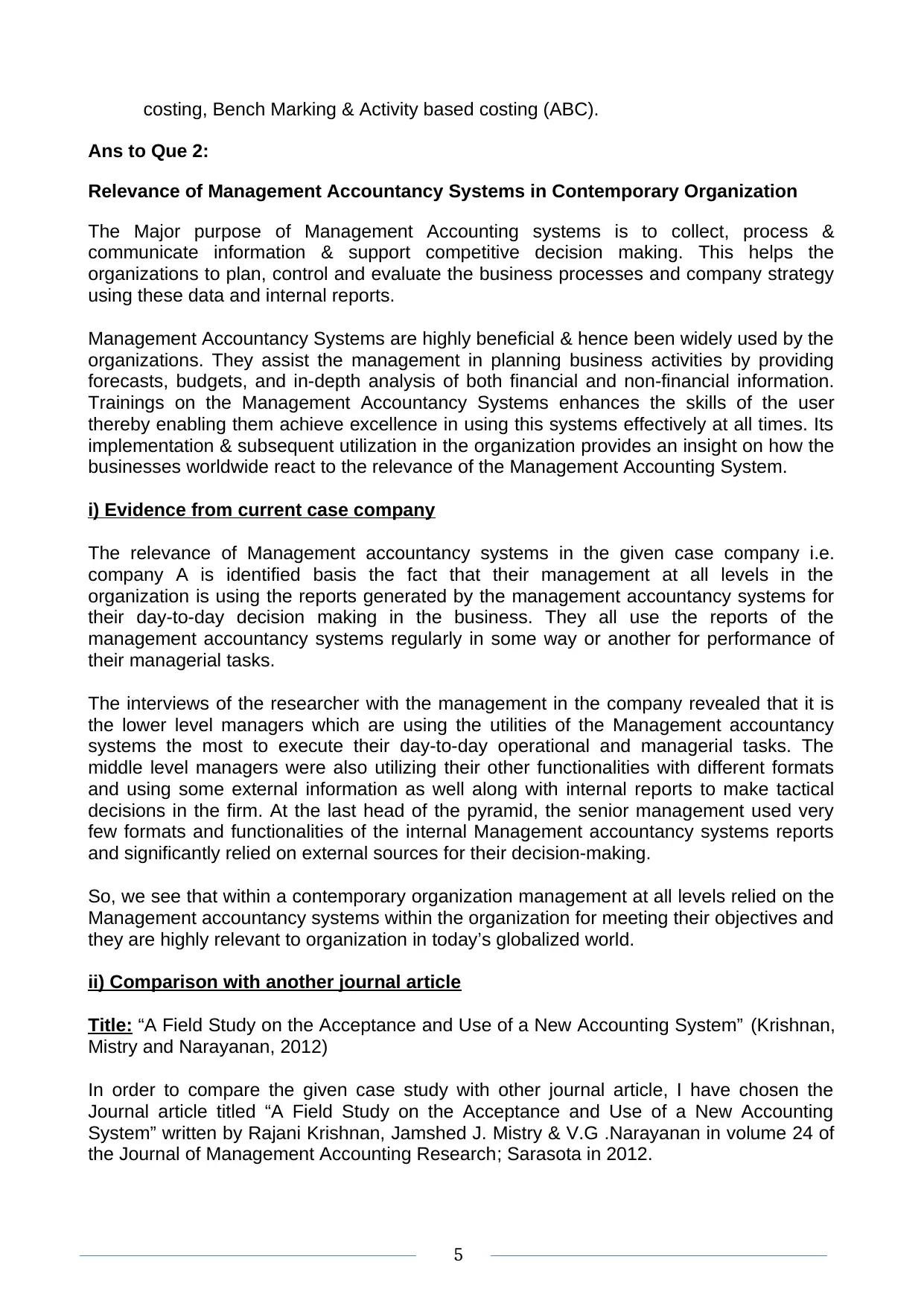
costing, Bench Marking & Activity based costing (ABC).
Ans to Que 2:
Relevance of Management Accountancy Systems in Contemporary Organization
The Major purpose of Management Accounting systems is to collect, process &
communicate information & support competitive decision making. This helps the
organizations to plan, control and evaluate the business processes and company strategy
using these data and internal reports.
Management Accountancy Systems are highly beneficial & hence been widely used by the
organizations. They assist the management in planning business activities by providing
forecasts, budgets, and in-depth analysis of both financial and non-financial information.
Trainings on the Management Accountancy Systems enhances the skills of the user
thereby enabling them achieve excellence in using this systems effectively at all times. Its
implementation & subsequent utilization in the organization provides an insight on how the
businesses worldwide react to the relevance of the Management Accounting System.
i) Evidence from current case company
The relevance of Management accountancy systems in the given case company i.e.
company A is identified basis the fact that their management at all levels in the
organization is using the reports generated by the management accountancy systems for
their day-to-day decision making in the business. They all use the reports of the
management accountancy systems regularly in some way or another for performance of
their managerial tasks.
The interviews of the researcher with the management in the company revealed that it is
the lower level managers which are using the utilities of the Management accountancy
systems the most to execute their day-to-day operational and managerial tasks. The
middle level managers were also utilizing their other functionalities with different formats
and using some external information as well along with internal reports to make tactical
decisions in the firm. At the last head of the pyramid, the senior management used very
few formats and functionalities of the internal Management accountancy systems reports
and significantly relied on external sources for their decision-making.
So, we see that within a contemporary organization management at all levels relied on the
Management accountancy systems within the organization for meeting their objectives and
they are highly relevant to organization in today’s globalized world.
ii) Comparison with another journal article
Title: “A Field Study on the Acceptance and Use of a New Accounting System” (Krishnan,
Mistry and Narayanan, 2012)
In order to compare the given case study with other journal article, I have chosen the
Journal article titled “A Field Study on the Acceptance and Use of a New Accounting
System” written by Rajani Krishnan, Jamshed J. Mistry & V.G .Narayanan in volume 24 of
the Journal of Management Accounting Research; Sarasota in 2012.
5
Ans to Que 2:
Relevance of Management Accountancy Systems in Contemporary Organization
The Major purpose of Management Accounting systems is to collect, process &
communicate information & support competitive decision making. This helps the
organizations to plan, control and evaluate the business processes and company strategy
using these data and internal reports.
Management Accountancy Systems are highly beneficial & hence been widely used by the
organizations. They assist the management in planning business activities by providing
forecasts, budgets, and in-depth analysis of both financial and non-financial information.
Trainings on the Management Accountancy Systems enhances the skills of the user
thereby enabling them achieve excellence in using this systems effectively at all times. Its
implementation & subsequent utilization in the organization provides an insight on how the
businesses worldwide react to the relevance of the Management Accounting System.
i) Evidence from current case company
The relevance of Management accountancy systems in the given case company i.e.
company A is identified basis the fact that their management at all levels in the
organization is using the reports generated by the management accountancy systems for
their day-to-day decision making in the business. They all use the reports of the
management accountancy systems regularly in some way or another for performance of
their managerial tasks.
The interviews of the researcher with the management in the company revealed that it is
the lower level managers which are using the utilities of the Management accountancy
systems the most to execute their day-to-day operational and managerial tasks. The
middle level managers were also utilizing their other functionalities with different formats
and using some external information as well along with internal reports to make tactical
decisions in the firm. At the last head of the pyramid, the senior management used very
few formats and functionalities of the internal Management accountancy systems reports
and significantly relied on external sources for their decision-making.
So, we see that within a contemporary organization management at all levels relied on the
Management accountancy systems within the organization for meeting their objectives and
they are highly relevant to organization in today’s globalized world.
ii) Comparison with another journal article
Title: “A Field Study on the Acceptance and Use of a New Accounting System” (Krishnan,
Mistry and Narayanan, 2012)
In order to compare the given case study with other journal article, I have chosen the
Journal article titled “A Field Study on the Acceptance and Use of a New Accounting
System” written by Rajani Krishnan, Jamshed J. Mistry & V.G .Narayanan in volume 24 of
the Journal of Management Accounting Research; Sarasota in 2012.
5
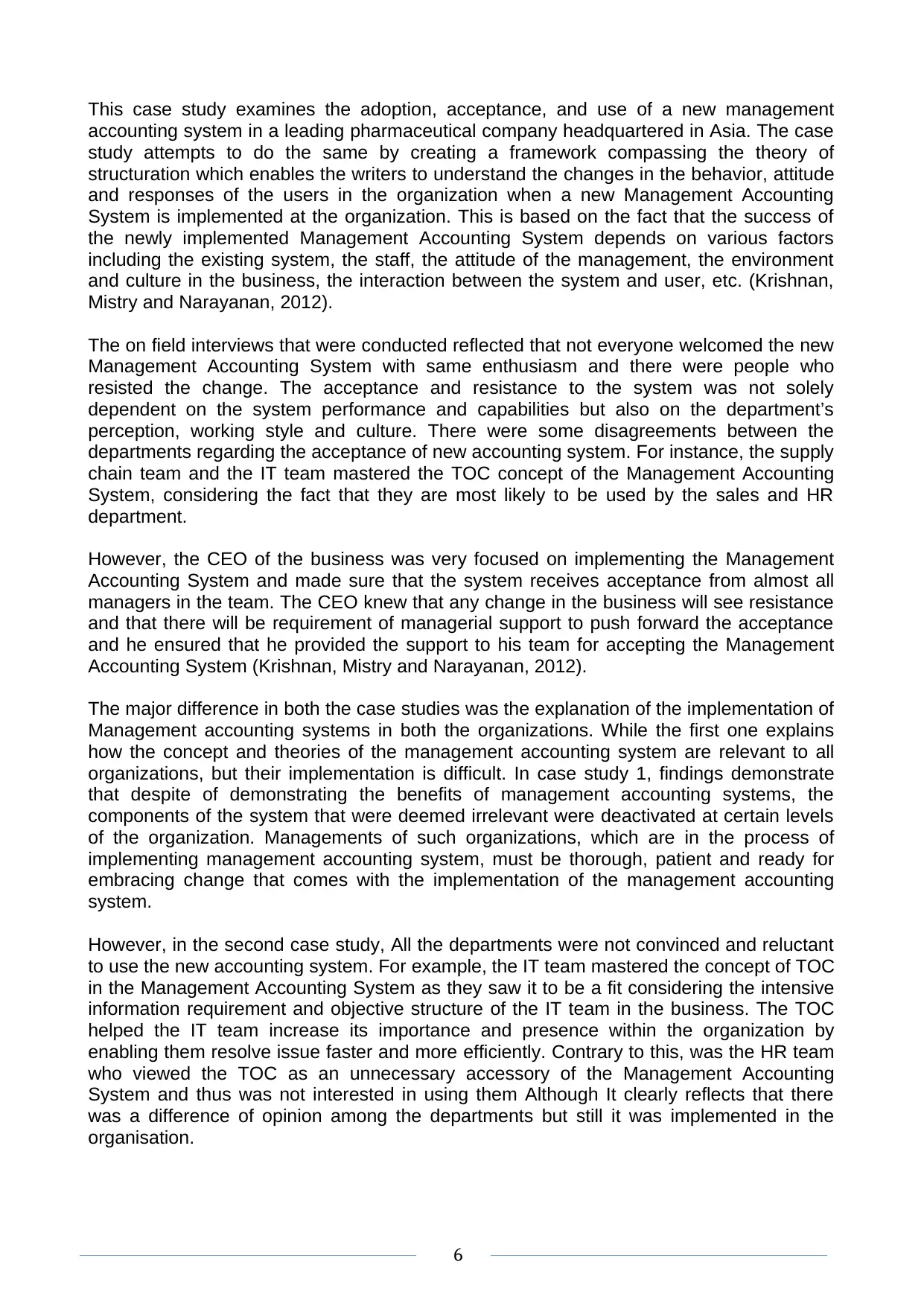
This case study examines the adoption, acceptance, and use of a new management
accounting system in a leading pharmaceutical company headquartered in Asia. The case
study attempts to do the same by creating a framework compassing the theory of
structuration which enables the writers to understand the changes in the behavior, attitude
and responses of the users in the organization when a new Management Accounting
System is implemented at the organization. This is based on the fact that the success of
the newly implemented Management Accounting System depends on various factors
including the existing system, the staff, the attitude of the management, the environment
and culture in the business, the interaction between the system and user, etc. (Krishnan,
Mistry and Narayanan, 2012).
The on field interviews that were conducted reflected that not everyone welcomed the new
Management Accounting System with same enthusiasm and there were people who
resisted the change. The acceptance and resistance to the system was not solely
dependent on the system performance and capabilities but also on the department’s
perception, working style and culture. There were some disagreements between the
departments regarding the acceptance of new accounting system. For instance, the supply
chain team and the IT team mastered the TOC concept of the Management Accounting
System, considering the fact that they are most likely to be used by the sales and HR
department.
However, the CEO of the business was very focused on implementing the Management
Accounting System and made sure that the system receives acceptance from almost all
managers in the team. The CEO knew that any change in the business will see resistance
and that there will be requirement of managerial support to push forward the acceptance
and he ensured that he provided the support to his team for accepting the Management
Accounting System (Krishnan, Mistry and Narayanan, 2012).
The major difference in both the case studies was the explanation of the implementation of
Management accounting systems in both the organizations. While the first one explains
how the concept and theories of the management accounting system are relevant to all
organizations, but their implementation is difficult. In case study 1, findings demonstrate
that despite of demonstrating the benefits of management accounting systems, the
components of the system that were deemed irrelevant were deactivated at certain levels
of the organization. Managements of such organizations, which are in the process of
implementing management accounting system, must be thorough, patient and ready for
embracing change that comes with the implementation of the management accounting
system.
However, in the second case study, All the departments were not convinced and reluctant
to use the new accounting system. For example, the IT team mastered the concept of TOC
in the Management Accounting System as they saw it to be a fit considering the intensive
information requirement and objective structure of the IT team in the business. The TOC
helped the IT team increase its importance and presence within the organization by
enabling them resolve issue faster and more efficiently. Contrary to this, was the HR team
who viewed the TOC as an unnecessary accessory of the Management Accounting
System and thus was not interested in using them Although It clearly reflects that there
was a difference of opinion among the departments but still it was implemented in the
organisation.
6
accounting system in a leading pharmaceutical company headquartered in Asia. The case
study attempts to do the same by creating a framework compassing the theory of
structuration which enables the writers to understand the changes in the behavior, attitude
and responses of the users in the organization when a new Management Accounting
System is implemented at the organization. This is based on the fact that the success of
the newly implemented Management Accounting System depends on various factors
including the existing system, the staff, the attitude of the management, the environment
and culture in the business, the interaction between the system and user, etc. (Krishnan,
Mistry and Narayanan, 2012).
The on field interviews that were conducted reflected that not everyone welcomed the new
Management Accounting System with same enthusiasm and there were people who
resisted the change. The acceptance and resistance to the system was not solely
dependent on the system performance and capabilities but also on the department’s
perception, working style and culture. There were some disagreements between the
departments regarding the acceptance of new accounting system. For instance, the supply
chain team and the IT team mastered the TOC concept of the Management Accounting
System, considering the fact that they are most likely to be used by the sales and HR
department.
However, the CEO of the business was very focused on implementing the Management
Accounting System and made sure that the system receives acceptance from almost all
managers in the team. The CEO knew that any change in the business will see resistance
and that there will be requirement of managerial support to push forward the acceptance
and he ensured that he provided the support to his team for accepting the Management
Accounting System (Krishnan, Mistry and Narayanan, 2012).
The major difference in both the case studies was the explanation of the implementation of
Management accounting systems in both the organizations. While the first one explains
how the concept and theories of the management accounting system are relevant to all
organizations, but their implementation is difficult. In case study 1, findings demonstrate
that despite of demonstrating the benefits of management accounting systems, the
components of the system that were deemed irrelevant were deactivated at certain levels
of the organization. Managements of such organizations, which are in the process of
implementing management accounting system, must be thorough, patient and ready for
embracing change that comes with the implementation of the management accounting
system.
However, in the second case study, All the departments were not convinced and reluctant
to use the new accounting system. For example, the IT team mastered the concept of TOC
in the Management Accounting System as they saw it to be a fit considering the intensive
information requirement and objective structure of the IT team in the business. The TOC
helped the IT team increase its importance and presence within the organization by
enabling them resolve issue faster and more efficiently. Contrary to this, was the HR team
who viewed the TOC as an unnecessary accessory of the Management Accounting
System and thus was not interested in using them Although It clearly reflects that there
was a difference of opinion among the departments but still it was implemented in the
organisation.
6
⊘ This is a preview!⊘
Do you want full access?
Subscribe today to unlock all pages.

Trusted by 1+ million students worldwide
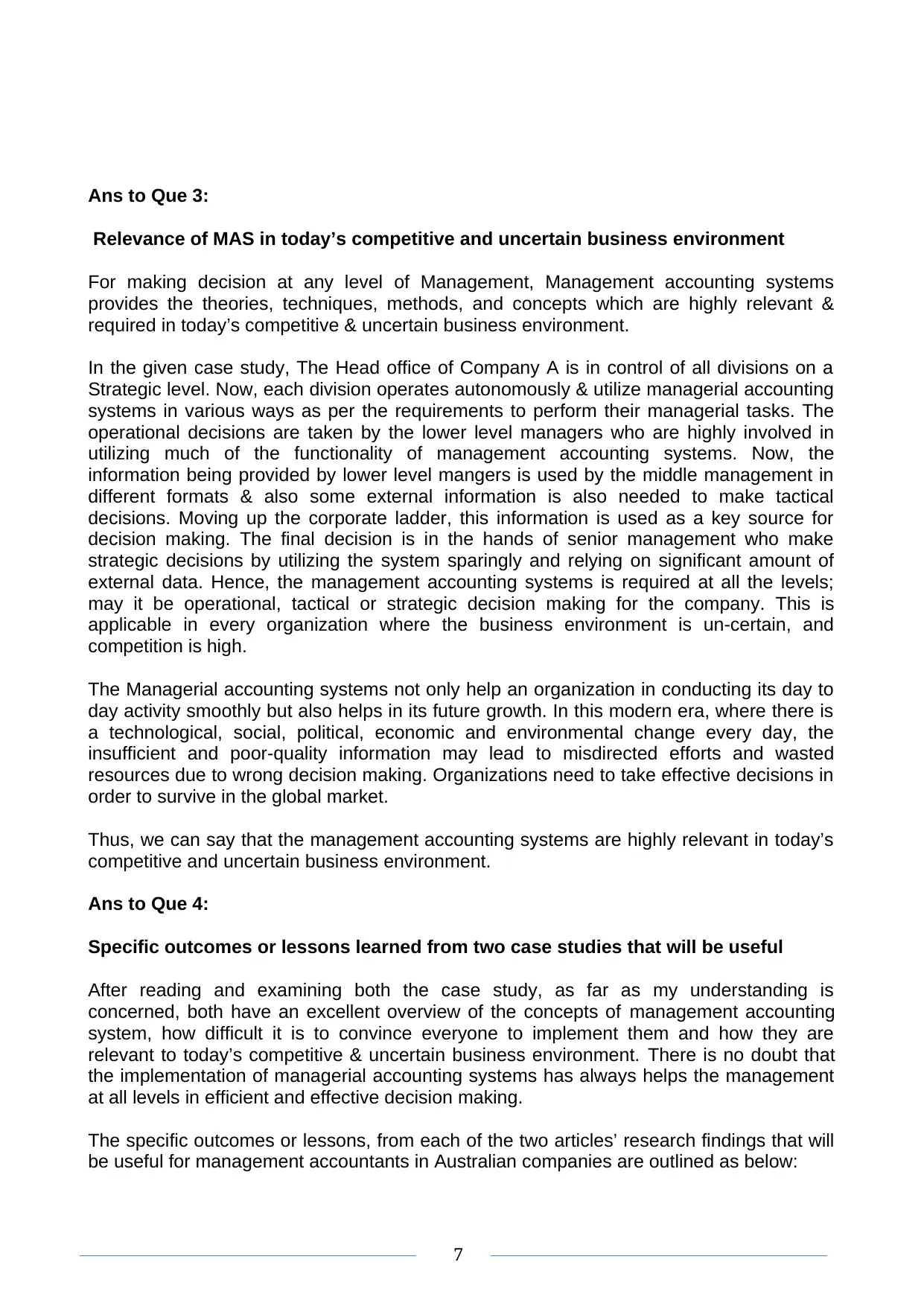
Ans to Que 3:
Relevance of MAS in today’s competitive and uncertain business environment
For making decision at any level of Management, Management accounting systems
provides the theories, techniques, methods, and concepts which are highly relevant &
required in today’s competitive & uncertain business environment.
In the given case study, The Head office of Company A is in control of all divisions on a
Strategic level. Now, each division operates autonomously & utilize managerial accounting
systems in various ways as per the requirements to perform their managerial tasks. The
operational decisions are taken by the lower level managers who are highly involved in
utilizing much of the functionality of management accounting systems. Now, the
information being provided by lower level mangers is used by the middle management in
different formats & also some external information is also needed to make tactical
decisions. Moving up the corporate ladder, this information is used as a key source for
decision making. The final decision is in the hands of senior management who make
strategic decisions by utilizing the system sparingly and relying on significant amount of
external data. Hence, the management accounting systems is required at all the levels;
may it be operational, tactical or strategic decision making for the company. This is
applicable in every organization where the business environment is un-certain, and
competition is high.
The Managerial accounting systems not only help an organization in conducting its day to
day activity smoothly but also helps in its future growth. In this modern era, where there is
a technological, social, political, economic and environmental change every day, the
insufficient and poor-quality information may lead to misdirected efforts and wasted
resources due to wrong decision making. Organizations need to take effective decisions in
order to survive in the global market.
Thus, we can say that the management accounting systems are highly relevant in today’s
competitive and uncertain business environment.
Ans to Que 4:
Specific outcomes or lessons learned from two case studies that will be useful
After reading and examining both the case study, as far as my understanding is
concerned, both have an excellent overview of the concepts of management accounting
system, how difficult it is to convince everyone to implement them and how they are
relevant to today’s competitive & uncertain business environment. There is no doubt that
the implementation of managerial accounting systems has always helps the management
at all levels in efficient and effective decision making.
The specific outcomes or lessons, from each of the two articles’ research findings that will
be useful for management accountants in Australian companies are outlined as below:
7
Relevance of MAS in today’s competitive and uncertain business environment
For making decision at any level of Management, Management accounting systems
provides the theories, techniques, methods, and concepts which are highly relevant &
required in today’s competitive & uncertain business environment.
In the given case study, The Head office of Company A is in control of all divisions on a
Strategic level. Now, each division operates autonomously & utilize managerial accounting
systems in various ways as per the requirements to perform their managerial tasks. The
operational decisions are taken by the lower level managers who are highly involved in
utilizing much of the functionality of management accounting systems. Now, the
information being provided by lower level mangers is used by the middle management in
different formats & also some external information is also needed to make tactical
decisions. Moving up the corporate ladder, this information is used as a key source for
decision making. The final decision is in the hands of senior management who make
strategic decisions by utilizing the system sparingly and relying on significant amount of
external data. Hence, the management accounting systems is required at all the levels;
may it be operational, tactical or strategic decision making for the company. This is
applicable in every organization where the business environment is un-certain, and
competition is high.
The Managerial accounting systems not only help an organization in conducting its day to
day activity smoothly but also helps in its future growth. In this modern era, where there is
a technological, social, political, economic and environmental change every day, the
insufficient and poor-quality information may lead to misdirected efforts and wasted
resources due to wrong decision making. Organizations need to take effective decisions in
order to survive in the global market.
Thus, we can say that the management accounting systems are highly relevant in today’s
competitive and uncertain business environment.
Ans to Que 4:
Specific outcomes or lessons learned from two case studies that will be useful
After reading and examining both the case study, as far as my understanding is
concerned, both have an excellent overview of the concepts of management accounting
system, how difficult it is to convince everyone to implement them and how they are
relevant to today’s competitive & uncertain business environment. There is no doubt that
the implementation of managerial accounting systems has always helps the management
at all levels in efficient and effective decision making.
The specific outcomes or lessons, from each of the two articles’ research findings that will
be useful for management accountants in Australian companies are outlined as below:
7
Paraphrase This Document
Need a fresh take? Get an instant paraphrase of this document with our AI Paraphraser
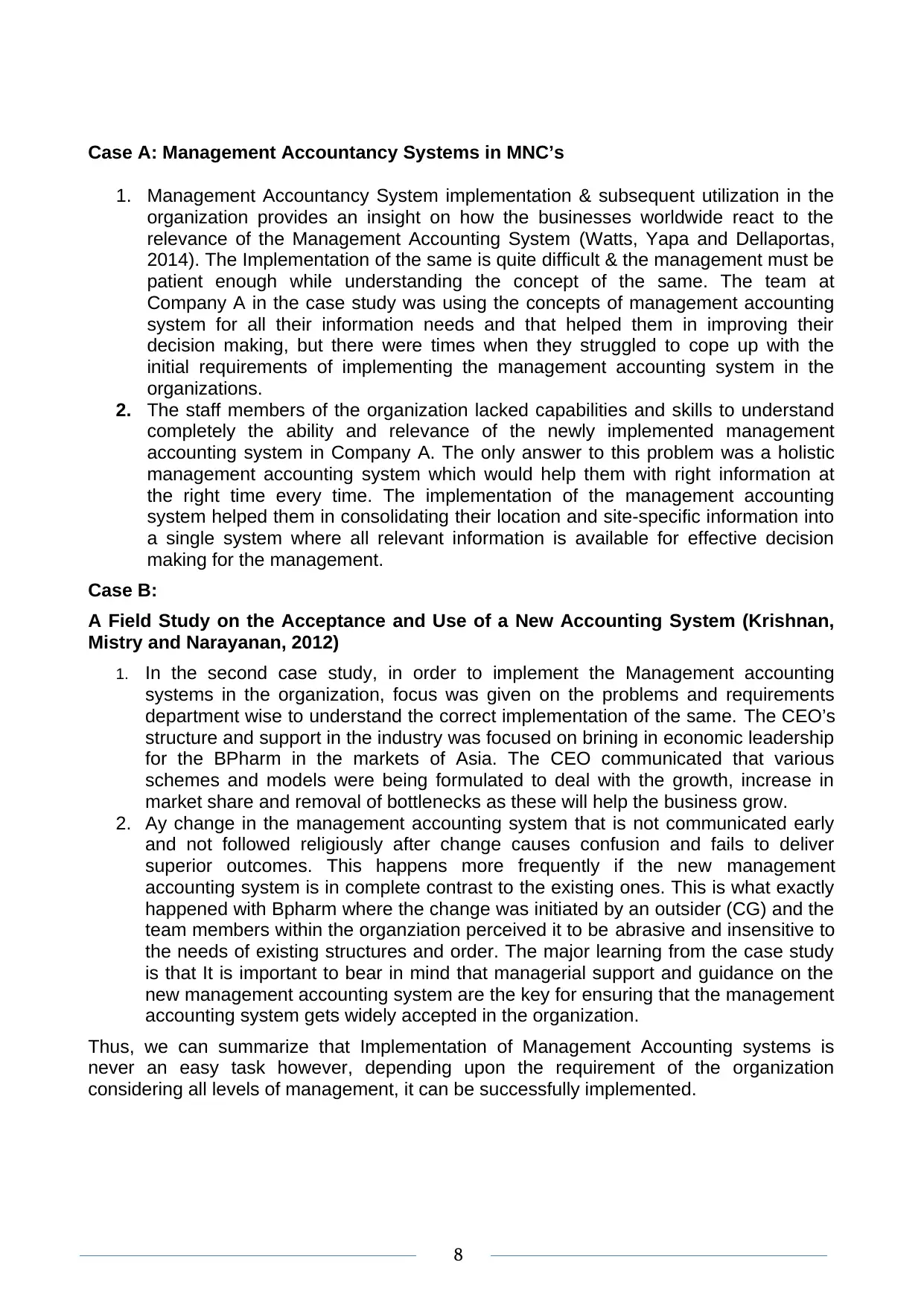
Case A: Management Accountancy Systems in MNC’s
1. Management Accountancy System implementation & subsequent utilization in the
organization provides an insight on how the businesses worldwide react to the
relevance of the Management Accounting System (Watts, Yapa and Dellaportas,
2014). The Implementation of the same is quite difficult & the management must be
patient enough while understanding the concept of the same. The team at
Company A in the case study was using the concepts of management accounting
system for all their information needs and that helped them in improving their
decision making, but there were times when they struggled to cope up with the
initial requirements of implementing the management accounting system in the
organizations.
2. The staff members of the organization lacked capabilities and skills to understand
completely the ability and relevance of the newly implemented management
accounting system in Company A. The only answer to this problem was a holistic
management accounting system which would help them with right information at
the right time every time. The implementation of the management accounting
system helped them in consolidating their location and site-specific information into
a single system where all relevant information is available for effective decision
making for the management.
Case B:
A Field Study on the Acceptance and Use of a New Accounting System (Krishnan,
Mistry and Narayanan, 2012)
1. In the second case study, in order to implement the Management accounting
systems in the organization, focus was given on the problems and requirements
department wise to understand the correct implementation of the same. The CEO’s
structure and support in the industry was focused on brining in economic leadership
for the BPharm in the markets of Asia. The CEO communicated that various
schemes and models were being formulated to deal with the growth, increase in
market share and removal of bottlenecks as these will help the business grow.
2. Ay change in the management accounting system that is not communicated early
and not followed religiously after change causes confusion and fails to deliver
superior outcomes. This happens more frequently if the new management
accounting system is in complete contrast to the existing ones. This is what exactly
happened with Bpharm where the change was initiated by an outsider (CG) and the
team members within the organziation perceived it to be abrasive and insensitive to
the needs of existing structures and order. The major learning from the case study
is that It is important to bear in mind that managerial support and guidance on the
new management accounting system are the key for ensuring that the management
accounting system gets widely accepted in the organization.
Thus, we can summarize that Implementation of Management Accounting systems is
never an easy task however, depending upon the requirement of the organization
considering all levels of management, it can be successfully implemented.
8
1. Management Accountancy System implementation & subsequent utilization in the
organization provides an insight on how the businesses worldwide react to the
relevance of the Management Accounting System (Watts, Yapa and Dellaportas,
2014). The Implementation of the same is quite difficult & the management must be
patient enough while understanding the concept of the same. The team at
Company A in the case study was using the concepts of management accounting
system for all their information needs and that helped them in improving their
decision making, but there were times when they struggled to cope up with the
initial requirements of implementing the management accounting system in the
organizations.
2. The staff members of the organization lacked capabilities and skills to understand
completely the ability and relevance of the newly implemented management
accounting system in Company A. The only answer to this problem was a holistic
management accounting system which would help them with right information at
the right time every time. The implementation of the management accounting
system helped them in consolidating their location and site-specific information into
a single system where all relevant information is available for effective decision
making for the management.
Case B:
A Field Study on the Acceptance and Use of a New Accounting System (Krishnan,
Mistry and Narayanan, 2012)
1. In the second case study, in order to implement the Management accounting
systems in the organization, focus was given on the problems and requirements
department wise to understand the correct implementation of the same. The CEO’s
structure and support in the industry was focused on brining in economic leadership
for the BPharm in the markets of Asia. The CEO communicated that various
schemes and models were being formulated to deal with the growth, increase in
market share and removal of bottlenecks as these will help the business grow.
2. Ay change in the management accounting system that is not communicated early
and not followed religiously after change causes confusion and fails to deliver
superior outcomes. This happens more frequently if the new management
accounting system is in complete contrast to the existing ones. This is what exactly
happened with Bpharm where the change was initiated by an outsider (CG) and the
team members within the organziation perceived it to be abrasive and insensitive to
the needs of existing structures and order. The major learning from the case study
is that It is important to bear in mind that managerial support and guidance on the
new management accounting system are the key for ensuring that the management
accounting system gets widely accepted in the organization.
Thus, we can summarize that Implementation of Management Accounting systems is
never an easy task however, depending upon the requirement of the organization
considering all levels of management, it can be successfully implemented.
8
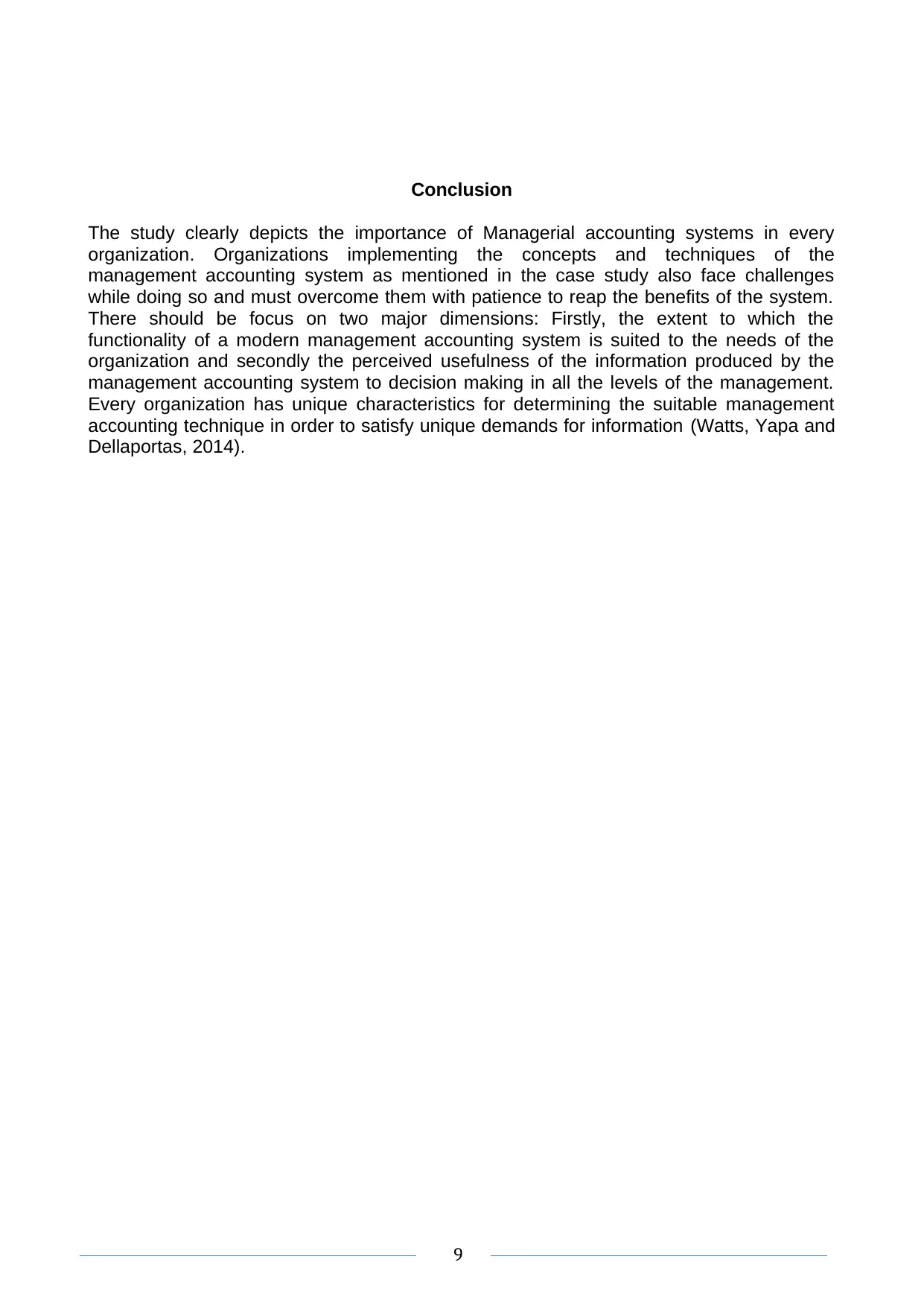
Conclusion
The study clearly depicts the importance of Managerial accounting systems in every
organization. Organizations implementing the concepts and techniques of the
management accounting system as mentioned in the case study also face challenges
while doing so and must overcome them with patience to reap the benefits of the system.
There should be focus on two major dimensions: Firstly, the extent to which the
functionality of a modern management accounting system is suited to the needs of the
organization and secondly the perceived usefulness of the information produced by the
management accounting system to decision making in all the levels of the management.
Every organization has unique characteristics for determining the suitable management
accounting technique in order to satisfy unique demands for information (Watts, Yapa and
Dellaportas, 2014).
9
The study clearly depicts the importance of Managerial accounting systems in every
organization. Organizations implementing the concepts and techniques of the
management accounting system as mentioned in the case study also face challenges
while doing so and must overcome them with patience to reap the benefits of the system.
There should be focus on two major dimensions: Firstly, the extent to which the
functionality of a modern management accounting system is suited to the needs of the
organization and secondly the perceived usefulness of the information produced by the
management accounting system to decision making in all the levels of the management.
Every organization has unique characteristics for determining the suitable management
accounting technique in order to satisfy unique demands for information (Watts, Yapa and
Dellaportas, 2014).
9
⊘ This is a preview!⊘
Do you want full access?
Subscribe today to unlock all pages.

Trusted by 1+ million students worldwide
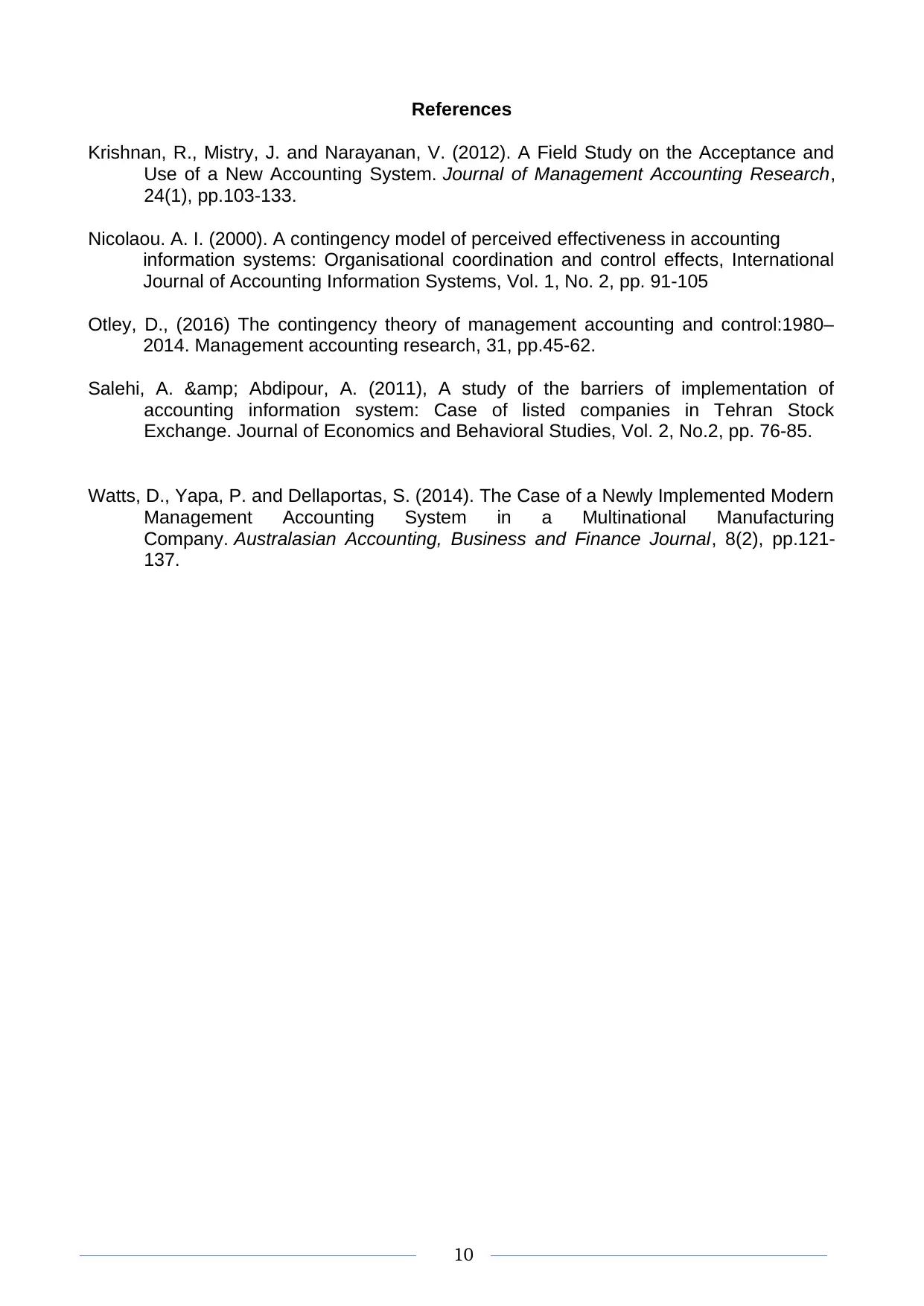
References
Krishnan, R., Mistry, J. and Narayanan, V. (2012). A Field Study on the Acceptance and
Use of a New Accounting System. Journal of Management Accounting Research,
24(1), pp.103-133.
Nicolaou. A. I. (2000). A contingency model of perceived effectiveness in accounting
information systems: Organisational coordination and control effects, International
Journal of Accounting Information Systems, Vol. 1, No. 2, pp. 91-105
Otley, D., (2016) The contingency theory of management accounting and control:1980–
2014. Management accounting research, 31, pp.45-62.
Salehi, A. & Abdipour, A. (2011), A study of the barriers of implementation of
accounting information system: Case of listed companies in Tehran Stock
Exchange. Journal of Economics and Behavioral Studies, Vol. 2, No.2, pp. 76-85.
Watts, D., Yapa, P. and Dellaportas, S. (2014). The Case of a Newly Implemented Modern
Management Accounting System in a Multinational Manufacturing
Company. Australasian Accounting, Business and Finance Journal, 8(2), pp.121-
137.
10
Krishnan, R., Mistry, J. and Narayanan, V. (2012). A Field Study on the Acceptance and
Use of a New Accounting System. Journal of Management Accounting Research,
24(1), pp.103-133.
Nicolaou. A. I. (2000). A contingency model of perceived effectiveness in accounting
information systems: Organisational coordination and control effects, International
Journal of Accounting Information Systems, Vol. 1, No. 2, pp. 91-105
Otley, D., (2016) The contingency theory of management accounting and control:1980–
2014. Management accounting research, 31, pp.45-62.
Salehi, A. & Abdipour, A. (2011), A study of the barriers of implementation of
accounting information system: Case of listed companies in Tehran Stock
Exchange. Journal of Economics and Behavioral Studies, Vol. 2, No.2, pp. 76-85.
Watts, D., Yapa, P. and Dellaportas, S. (2014). The Case of a Newly Implemented Modern
Management Accounting System in a Multinational Manufacturing
Company. Australasian Accounting, Business and Finance Journal, 8(2), pp.121-
137.
10
1 out of 10
Related Documents
Your All-in-One AI-Powered Toolkit for Academic Success.
+13062052269
info@desklib.com
Available 24*7 on WhatsApp / Email
![[object Object]](/_next/static/media/star-bottom.7253800d.svg)
Unlock your academic potential
Copyright © 2020–2025 A2Z Services. All Rights Reserved. Developed and managed by ZUCOL.





